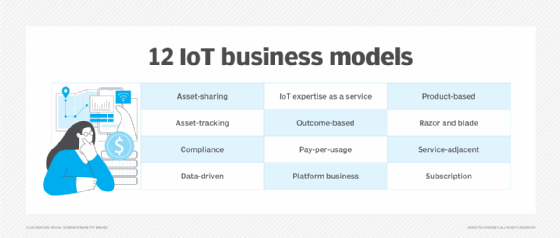12 top IoT business models for 2025
Incorporating IoT into business models delivers valuable product and customer data in real time that can streamline operations, improve CX and diversify revenue streams.
IoT technology is an intriguing way to redefine business models in 2025. Companies are poised to navigate rapidly evolving technology and regulatory landscapes with advanced digital transformations in nearly every industry. With the explosion in AI tools, IoT is unlocking new opportunities for data-driven innovation and operational efficiency. Distributed cloud environments enable real-time processing closer to data sources for higher performance and enhanced compliance.
Meanwhile, data protection regulations and growing sustainability demands are compelling businesses to rethink their IoT strategies. Adaptable and forward-thinking businesses already know that IoT delivers value to themselves and their customers. There are many ways to incorporate IoT into business models. Many businesses are combining them in creative ways to maximize their opportunities and diversify their revenue streams. IoT business models can help companies evolve as fast as their consumer needs and preferences change. The model they choose or create from among these 12 is only restricted by creativity and the willingness to experiment.
1. Product-based model
The easiest model is for manufacturing and selling IoT devices, whether it's a smart home appliance, the hardware that goes into the devices or other consumer products. The company generates revenues from the sale of the devices and any customized adjacent products needed for them. The downside to only producing devices is that businesses must constantly innovate to keep up with technology and changing consumer needs and preferences. That's why many IoT device manufacturers add a secondary business model to their device manufacturing.
2. Platform-based business model
The platform-based business model synergistically benefits manufacturers and consumers in the marketplace. The key is interoperability and the interconnection of the devices and the company to generate revenue from related transactions. Amazon generates data through its Alexa voice recognition platform and uses that information to sell related products to consumers. Amazon charges third-party vendors and developers to create and release services on the platform, increasing its revenue and market reach.
3. Subscription model
Companies can use the always-on connectivity of IoT devices to develop a recurring revenue business or subscription model. Like the as-a-service business model for technology, an IoT subscription model enables the delivery of continuous value to customers for a regular fee. The IoT device breaks down the barrier between businesses and their customers, fostering an active ongoing relationship instead of a transactional one. The device gathers more data about customers over time and gives businesses the chance to provide valuable features and products tailored to unique customer needs.
4. Pay-per-usage model
Active sensors on IoT devices regularly monitor a customer's environment to see how much they use a product or service, providing businesses the opportunity to use a pay-per-usage business model where customers are charged for the amount of time they actively interact with a product. Many auto insurance companies use this model to offer a mileage-based insurance plan to customers. People don't pay for the IoT device installed in their car that tracks their driving usage and habits. Instead, they pay for the lower rates based on the data they generate on the device. Rolls-Royce's TotalCare program charges airlines on a fixed dollar-per-flying-hour basis for the use of its engines on their planes. Rolls-Royce retains ownership of the engines and actively maintains them through IoT sensors that send telemetry in real time to their monitoring sensors.
5. Asset-sharing model
Many industries make big expenditures on vital equipment. Companies want to be sure they're getting the maximum benefit from the equipment to merit the expense. An asset-sharing business model for IoT enables businesses to sell their extra capacity back to the market, so each company pays a reduced price for the equipment and during usage. Businesses could use this model on their own assets or as their main business by renting out large assets for sharing. For consumers, this approach resembles car- and scooter-sharing companies, such as Zipcar and Share Now. For industrial firms in construction and mining, it means partnering with nearby businesses to share the cost of heavy machinery. IoT sensors track the location and usage of the machines while minimizing breakdowns by monitoring engine data in real time. Customers have access to the data and reserve time on the machines as needed.

6. Asset-tracking model
Connected devices in the supply chain help businesses identify, monitor and track assets in real time. It helps them protect in-field assets from loss or theft while monitoring for maintenance purposes. With the data generated by connected devices on these assets, businesses can check their status regularly and know when to repair, fix or replace assets before they fail. This business model can also track the supply chain to identify inefficiencies, optimize workflows and increase visibility into usage.
Semtech helps global companies track their cold chain cargo integrity with high-value IoT asset-tracking platforms. Temperature-sensitive cargo, such as food, produce and pharmaceuticals, requires precise temperature controls throughout the cold chain to maintain the integrity of the loads. As pressures mount for the refrigerated cargo industry as a whole, carriers can use these types of IoT sensors and online tracking platforms to ensure complete visibility of cargo, maintain adequate temperatures and take swift action on any identified issues.
7. Outcome-based model
Customers pay for the outcome of the IoT product, not the product itself. Many models are outcome-based, focusing more on what customers gain from the device rather than the device itself. With this model, self-monitoring products can automatically reorder replacement parts or create a service request. Outcome-based models are expanding rapidly in healthcare with wearables and self-monitoring instruments that notify care providers and patients of significant changes. Propeller Health in the U.S. and QioT Connected Healthcare in the U.K. have developed asthma inhaler products that connect to online platforms to manage pulmonary health. AliveCor's KardiaMobile program offers a personal EKG device for heart patients and Aeris Communications provides a platform for medical device manufacturers and healthcare providers to maintain contact with patients so they comply with medical advice such as medication dosage. Patients and providers use these IoT devices and platforms to inform treatment plans and identify better outcomes.
8. Compliance model
Compliance tracking is vital to many industries and costs a lot of time, effort and money. Depending on the industry, there might be significant checks that must be done for safety, environmental or legal reasons. Deploying IoT devices in the field can help reduce the cost of compliance by making companies more responsive to changes before they become a problem. IBM's Vegetation Management platform combines weather, satellite and IoT data to help utilities make better decisions as well as increase reliability and customer satisfaction in a highly regulated industry. The platform helps utilities monitor sites in real time and offers relevant insights to help with budget allocation, work planning, hazard reporting and regulatory reporting. Willard IoT, in conjunction with IBM, offers a smart, IoT-driven method to monitor and ensure compliance with National Fire Protection Association regulations for public buildings and facilities. The IoT compliance platform monitors exit sign status and health and displays the data in a dashboard for easy viewing and verification.
9. Data-driven model
Data generated by devices power the data-driven model. A company builds a product that provides value to customers and collects data that can be used for other products or sold to a third party. The model works well when many devices in the field are collecting customer data. There are many ways to use this business model outside of the classic online shopping model in which consumers get product suggestions based on their browsing or purchasing history. In office buildings, energy efficiency devices can monitor energy consumption and be used by landlords to manage HVAC and energy usage throughout the day. This data can also be sold to utility companies for forecasting purposes as they manage the local energy grid.
10. Service-adjacent model
A company offers a service that enhances the use of an IoT device, but it doesn't necessarily sell the device. The device is the enabler of the company's service, not the main part of the business. An IoT device can be used to monitor a network or system, predict maintenance timelines and sell a maintenance contract to customers. The company doesn't necessarily create, develop or even install the device, but it might partner with an IoT manufacturer to create a service industry that supports the device.
11. IoT expertise as a service
The fast-evolving technical labor market and workforce reductions to save costs are creating knowledge and resource gaps for companies with IoT fleets. IoT device manufacturers and managed service providers could respond by offering their expertise as a service to customers. They could assist customers with setup and deployment of their fleet, offer maintenance and upgrades, and design bespoke offerings using IoT devices. Customers save the cost of technical personnel and continuous training and have access to the latest knowledge and skills. Tech companies such as Qualcomm, NTT and Cisco offer IoT as a service to help entities across various domains, including fleet management, predictive maintenance and connected factories. Industry-specific tech companies -- like Newtrax, a division of Sandvik Mining and Rock Technology -- offer custom IoT as a service in the underground mining industry to expedite digital transformation efforts in an industrial environment.
12. Razor-and-blade model for IoT
Also known as the bait-and-hook business model, razor and blade is well-established in the business world. Companies like Gilette, HP and Nespresso have been successfully using this model for decades. Companies sell a starting product at a low cost and combine it with the sales of a related product later. Customers can continue to use the initial product, and the company has continuous revenues from each additional purchase. The model could entail the sale of a device combined with an ongoing maintenance plan, a subscription to a data analytics platform that uses data taken from the IoT devices, or an annual subscription that gives customers first dibs on newer devices at regular intervals, thereby lowering the cost of individual devices. The possibilities are endless.
Editor's note: This article was updated in January 2025 to reflect the latest developments in IoT business models.
Julia Borgini is a freelance technical copywriter and content marketing strategist who helps B2B technology companies publish valuable content.








